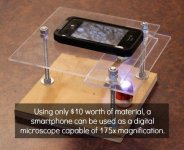Banefoul
Member
http://www.instructables.com/id/10-Smartphone-to-digital-microscope-conversion/
[youtubeif]KpMTkr_aiYU#t[/youtubeif]
Materials required:
3x 4 ½” x 5/16” carriage bolts
9x 5/16” nuts
3x 5/16” wing nuts
5x 5/16” washers
¾” x 7” x 7” plywood -- for the base
⅛” x 7” x 7” plexiglass -- for the camera stage
⅛” x 3” x 7” plexiglass -- for the specimen stage
laser pointer focus lens
LED click light (necessary only for viewing backlit specimens)
Tools:
Drill
Assorted bits
Ruler
``````````````````````````````````````````````
The focus lens of just about any laser pointer will act as the macro lens on the microscope stand. Don't waste money on an expensive model; the lens from the $2 laser is fine.
To get the lens from the laser pointer start by unscrewing the front cone and the back cover of the tube. Remove the batteries. Using the eraser end of a pencil, push the innards out of the front of the tube. The front of this assembly (the side without the spring to contact the batteries) is where the focus lens sits. Unscrew the small black piece of plastic in front of the lens and the lens will come free.
The lens, when viewed from the side is not symmetrical. You’ll see a thin translucent strip (~1mm) on one side of the lens. That side must not be adjacent to the camera. You can determine the correct orientation by sticking the lens between the prongs of a hairpin and taping the rig to the back of a smartphone. The correct orientation will provide you with a larger field of view.
As it is, you can take reasonably good macro photos with this lens and smartphone. This simple rig is limited; not to mention, it’s extremely hard to keep the phone steady when taking zoomed in photos. That’s why we need to build a stand!
Make a mark with a Sharpie on the front two corners of the plywood base ¾” from both the sides and the front edges.
Put a sacrificial piece of wood beneath the plywood base before drilling. You don’t want to damage surface of the bench! Stack the plexiglass camera stage (7” x 7” piece) on top of the base. Then stack the specimen stage (3” x 7”) on top of the camera stage with ¾” of the stage extending off the front of the base.
Drill through the entire assembly. The bolts that stick up through the base must be countersunk in order for the stand to sit flat. Flip the base over and counter sink the holes with a spade bit.
Find a drill bit that is the same size as or smaller than the diameter of the lens. Remember, you can always take more plexi away; adding extra plexiglass after drilling is not an option.
¾” from the front of the camera stage (in line with the bolt holes) drill a hole for the lens.
If the lens doesn’t quite fit, file or use sandpaper to enlarge the hole. Be sure to do this slowly and test the fit often. It is easy to overshoot and make the hole too large!
When using the stand, it is important to have the lens as close as possible to the camera. If you don’t plan on having your phone in a case when you use the stand, make the lens flush with the stage. Otherwise, leave the top of the lens slightly exposed (as is done in the image) so that the lens will rest closer to the camera.
It is important that a hole for your light source is directly below the focus lens. The best way to mark the placement of the light is to slide the camera stage (without the lens) down to the base, mark with a pencil where the hole is to be drilled, and drill a shallow hole to rest the light in.
We are ready to assemble! Start with washers and nuts to hold the bolts tight to the base. Then add some upside down wing nuts and then washers to the two front bolts. Place the specimen stage on top of the washers and add a nut to each bolt. Lower them about 1/2” and rest the camera stage on top of these nuts. A level is handy here to make sure that the stage is actually flat. If you don’t own a level there are plenty of free level apps for a phone! When the stage is level both front to back and left to right, tighten down the final nuts.
Go take some pictures! Or video! With $10 worth of materials and a smartphone, you just made a digital microscope!
Plant cells tend to work best for this particular model, but feel free to experiment. That’s what this is all about, giving you the freedom to explore.
I am a major proponent of making home science more accessible. My goal in designing and building this phone to microscope conversion stand is to provide an alternative to overly expensive microscopes. This set up is a viable option for underfunded science classrooms that would not otherwise be able to perform experiments requiring a microscope. But more than that, this device will allow people to rediscover the world around them.
`````````````````````````````````````````````````````````````````````````
KICK ASS am i right??? people keep saying they need better cams or other things NOW you can take and post amazing micro photos.
you are welcome.



